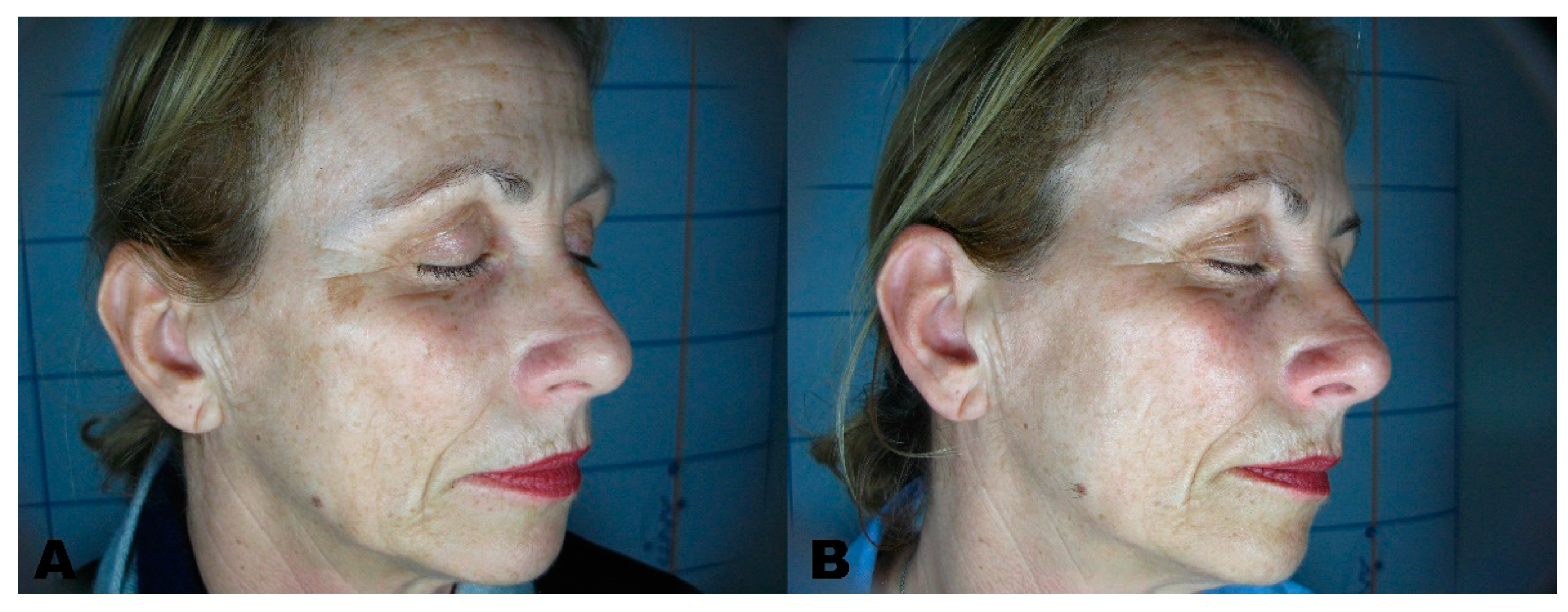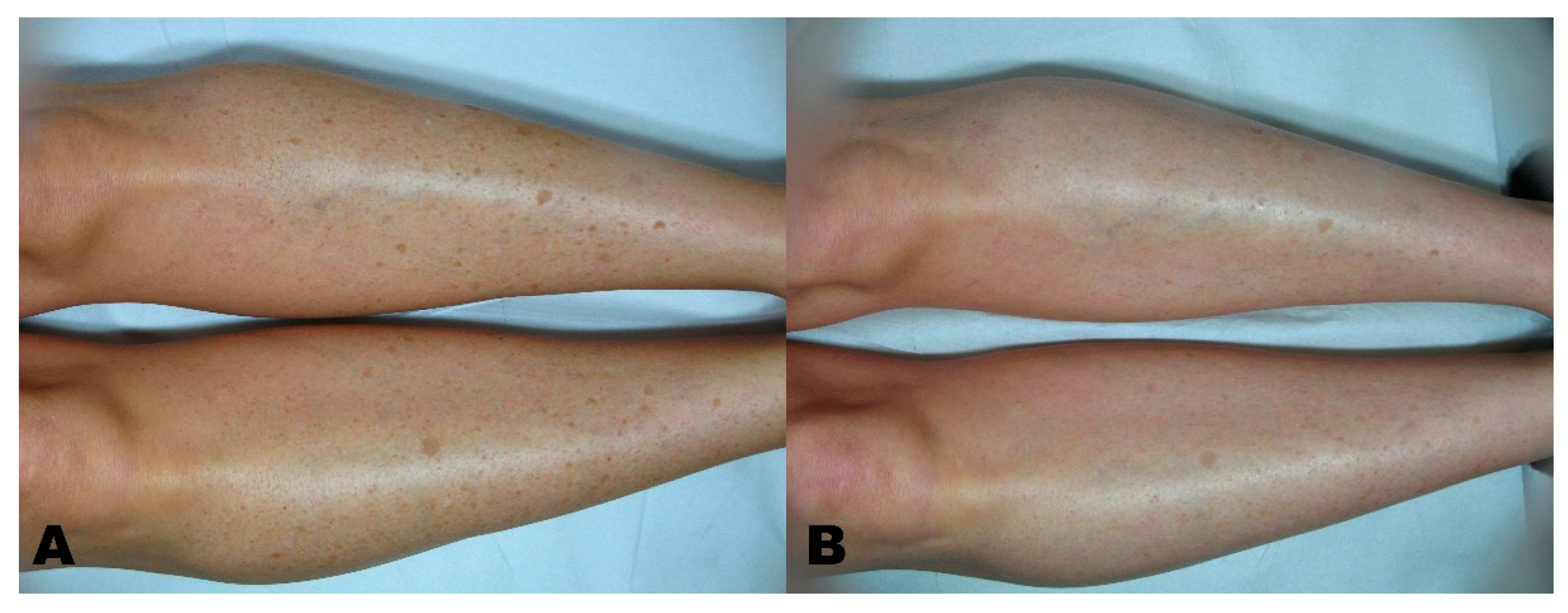Nanosecond Q-Switched 1064/532 nm Laser to Treat Hyperpigmentations: A Double Center Retrospective Study
Abstract
:1. Introduction
2. Materials and Methods
3. Results
4. Discussion
5. Conclusions
Author Contributions
Funding
Institutional Review Board Statement
Informed Consent Statement
Data Availability Statement
Acknowledgments
Conflicts of Interest
References
- Aurangabadkar, S.J. Optimizing Q-switched lasers for melasma and acquired dermal melanoses. Indian J. Dermatol. Venereol. Leprol. 2019, 85, 10–17. [Google Scholar] [CrossRef] [PubMed]
- Sofen, B.; Prado, G.; Emer, J. Melasma and Post Inflammatory Hyperpigmentation: Management Update and Expert Opinion. Ski. Ther. Lett. 2016, 21, 1–7. [Google Scholar]
- Nistico, S.P.; Silvestri, M.; Zingoni, T.; Tamburi, F.; Bennardo, L.; Cannarozzo, G. Combination of Fractional CO2 Laser and Rhodamine-Intense Pulsed Light in Facial Rejuvenation: A Randomized Controlled Trial. Photobiomodul. Photomed. Laser Surg. 2021, 39, 113–117. [Google Scholar] [CrossRef] [PubMed]
- Lodi, G.; Sannino, M.; Caterino, P.; Cannarozzo, G.; Bennardo, L.; Nisticò, S.P. Fractional CO2 laser-assisted topical rifamycin drug delivery in the treatment of pediatric cutaneous leishmaniasis. Pediatr. Dermatol. 2021, 38, 717–720. [Google Scholar] [CrossRef] [PubMed]
- Mercuri, S.R.; Brianti, P.; Dattola, A.; Bennardo, L.; Silvestri, M.; Schipani, G.; Nisticò, S.P. CO2 laser and photodynamic therapy: Study of efficacy in periocular BCC. Dermatol. Ther. 2018, 31, e12616. [Google Scholar] [CrossRef]
- Cannarozzo, G.; Bennardo, L.; Negosanti, F.; Nisticò, S.P. CO2 Laser Treatment in Idiopathic Scrotal Calcinosis: A Case Series. J. Lasers Med. Sci. 2020, 11, 500–501. [Google Scholar] [CrossRef]
- Fabi, S.G.; Friedmann, D.P.; Niwa Massaki, A.B.; Goldman, M.P. A randomized, split-face clinical trial of low-fluence Q-switched neodymium-doped yttrium aluminum garnet (1064 nm) laser versus low-fluence Q-switched alexandrite laser (755 nm) for the treatment of facial melasma. Lasers Surg. Med. 2014, 46, 531–537. [Google Scholar] [CrossRef]
- Vachiramon, V.; Panmanee, W.; Techapichetvanich, T.; Chanprapaph, K. Comparison of Q-switched Nd: YAG laser and fractional carbon dioxide laser for the treatment of solar lentigines in Asians. Lasers Surg. Med. 2016, 48, 354–359. [Google Scholar] [CrossRef]
- Cannarozzo, G.; Negosanti, F.; Sannino, M.; Santoli, M.; Bennardo, L.; Banzola, N.; Negosanti, L.; Nisticò, S.P. Q-switched Nd:YAG laser for cosmetic tattoo removal. Dermatol. Ther. 2019, 32, e13042. [Google Scholar] [CrossRef]
- Karadağ Köse, Ö.; Borlu, M. Efficacy of the combination of Q-switched Nd:YAG laser and microneedling for melasma. J. Cosmet. Dermatol. 2021, 20, 769–775. [Google Scholar] [CrossRef] [PubMed]
- Williams, N.M.; Gurnani, P.; Long, J.; Reynolds, J.; Pan, Y.; Suzuki, T.; Alhetheli, G.I.; Nouri, K. Comparing the efficacy and safety of Q-switched and picosecond lasers in the treatment of nevus of Ota: A systematic review and meta-analysis. Lasers Med. Sci. 2021, 36, 723–733. [Google Scholar] [CrossRef] [PubMed]
- Belkin, D.A.; Jeon, H.; Weiss, E.; Brauer, J.A.; Geronemus, R.G. Successful and safe use of Q-switched lasers in the treatment of nevus of Ota in children with phototypes IV–VI. Lasers Surg. Med. 2018, 50, 56–60. [Google Scholar] [CrossRef]
- Trivedi, M.K.; Yang, F.C.; Cho, B.K. A review of laser and light therapy in melasma. Int. J. Womens Dermatol. 2017, 3, 11–20. [Google Scholar] [CrossRef] [PubMed]
- Robredo, I.G.C. Q-Switched 1064 nm Nd:YAG Laser in Treating Axillary Hyperpigmentation in Filipino Women with Skin Types IV–V. J. Drugs Dermatol. 2020, 19, 66–69. [Google Scholar] [CrossRef] [PubMed]
- Rutnin, S.; Pruettivorawongse, D.; Thadanipon, K.; Vachiramon, V. A Prospective Randomized Controlled Study of Oral Tranexamic Acid for the Prevention of Postinflammatory Hyperpigmentation after Q-Switched 532-nm Nd:YAG Laser for Solar Lentigines. Lasers Surg. Med. 2019, 51, 850–858. [Google Scholar] [CrossRef] [PubMed]
- Imokawa, G. Melanocyte Activation Mechanisms and Rational Therapeutic Treatments of Solar Lentigos. Int. J. Mol. Sci. 2019, 20, 3666. [Google Scholar] [CrossRef] [Green Version]
- Vachiramon, V.; Iamsumang, W.; Triyangkulsri, K. Q-switched double frequency Nd:YAG 532-nm nanosecond laser vs. double frequency Nd:YAG 532-nm picosecond laser for the treatment of solar lentigines in Asians. Lasers Med. Sci. 2018, 33, 1941–1947. [Google Scholar] [CrossRef]
- Beyzaee, A.M.; Patil, A.; Goldust, M.; Moslemi, M.; Kazeminejad, A.; Rokni, G.R. Comparative Efficacy of Fractional CO2 Laser and Q-Switched Nd:YAG Laser in Combination Therapy with Tranexamic Acid in Refractory Melasma: Results of a Prospective Clinical Trial. Cosmetics 2021, 8, 37. [Google Scholar] [CrossRef]
- Aladrén, S.; Garre, A.; Valderas-Martínez, P.; Piquero-Casals, J.; Granger, C. Efficacy and Safety of an Oral Nutritional (Dietary) Supplement Containing Pinus pinaster Bark Extract and Grape Seed Extract in Combination with a High SPF Sunscreen in the Treatment of Mild-to-Moderate Melasma: A Prospective Clinical Study. Cosmetics 2019, 6, 15. [Google Scholar] [CrossRef] [Green Version]
- Nisticò, S.P.; Tolone, M.; Zingoni, T.; Tamburi, F.; Scali, E.; Bennardo, L.; Cannarozzo, G. A New 675 nm Laser Device in the Treatment of Melasma: Results of a Prospective Observational Study. Photobiomodul. Photomed. Laser Surg. 2020, 38, 560–564. [Google Scholar] [CrossRef]
- Liu, C.-H.; Shieh, C.-S.; Huang, T.-L.; Lin, C.-H.; Chao, P.-J.; Huang, Y.-J.; Lee, H.-F.; Yeh, S.-A.; Tseng, C.-D.; Wu, J.-M.; et al. Evaluating the Risk Factors of Post Inflammatory Hyperpigmentation Complications with Nd-YAG Laser Toning Using LASSO-Based Algorithm. Appl. Sci. 2020, 10, 2049. [Google Scholar] [CrossRef] [Green Version]
- Goldust, M.; Wollina, U. Periorbital Hyperpigmentation—Dark Circles under the Eyes; Treatment Suggestions and Combining Procedures. Cosmetics 2021, 8, 26. [Google Scholar] [CrossRef]
- Del Duca, E.; Zingoni, T.; Bennardo, L.; Di Raimondo, C.; Garofalo, V.; Sannino, M.; Petrini, N.; Cannarozzo, G.; Bianchi, L.; Nisticò, S.P. Long-Term Follow-Up for Q-Switched Nd:YAG Treatment of Nevus of Ota: Are High Number of Treatments Really Required? A Case Report. Photobiomodul. Photomed. Laser Surg. 2021, 39, 137–140. [Google Scholar] [CrossRef] [PubMed]
- Kim, J.S.; Nam, C.H.; Kim, J.Y.; Gye, J.W.; Hong, S.P.; Kim, M.H.; Park, B.C. Objective Evaluation of the Effect of Q-Switched Nd:YAG (532 nm) Laser on Solar Lentigo by Using a Colorimeter. Ann. Dermatol. 2015, 27, 326–328. [Google Scholar] [CrossRef] [Green Version]
- Kim, H.O.; Kim, H.R.; Kim, J.C.; Kang, S.Y.; Jung, M.J.; Chang, S.E.; Park, C.W.; Chung, B.Y. A Randomized Controlled Trial on the Effectiveness of Epidermal Growth Factor-Containing Ointment on the Treatment of Solar Lentigines as Adjuvant Therapy. Med. Kaunas 2021, 57, 166. [Google Scholar] [CrossRef]
- Passeron, T.; Genedy, R.; Salah, L.; Fusade, T.; Kositratna, G.; Laubach, H.J.; Marini, L.; Badawi, A. Laser treatment of hyperpigmented lesions: Position statement of the European Society of Laser in Dermatology. J. Eur. Acad. Dermatol. Venereol. 2019, 33, 987–1005. [Google Scholar] [CrossRef] [PubMed]





| Patient No. | 96 |
|---|---|
| Female (%) | 47 (49.0%) |
| Male (%) | 49 (51.0%) |
| Mean Age ± SD [years] | 50.0 ± 17.3 |
| Age range [years] | 19–77 |
| Fitzpatrick phototype: | |
| II (%) | 38 (39.6%) |
| III (%) | 28 (29.2%) |
| IV (%) | 30 (31.3%) |
| Hyperpigmentation depth: | |
| Epidermal (%) | 92 (95.8%) |
| Dermal (%) | 4 (4.2%) |
| Hyperpigmentation location: | |
| Face (%) | 72 (75.0%) |
| Hand (%) | 12 (12.5%) |
| Trunk (%) | 12 (12.5%) |
| Mean No. Sessions ± SD | No. Sessions Range | Dermatologist Evaluation | Patient VAS Score | |
|---|---|---|---|---|
| All patients | 1.2 ± 0.7 | 1–5 | 3.85 ± 0.41 | 8.91 ± 1.07 |
| Fitzpatrick phototype: | ||||
| II | 1.3 ± 0.9 | 1–5 | 3.84 ± 0.44 | 9.10 ± 0.96 |
| III | 1.1 ± 0.3 | 1–2 | 4 | 9.07 ± 0.26 |
| IV | 1.3 ± 0.8 | 1–5 | 3.73 ± 0.52 | 8.34 ± 1.45 |
| Hyperpigmentation depth | ||||
| Epidermal | 1.1 ± 0.3 | 1–2 | 3.88 ± 0.36 | 9 ± 0.94 |
| Dermal | 4.3 ± 1.0 | 3–5 | 3.25 ± 0.96 | 6.75 ± 1.71 |
| Hyperpigmentation location | ||||
| Face | 1.3 ± 0.8 | 1–5 | 3.82 ± 0.45 | 8.78 ± 1.17 |
| Hand | 1.0 ± 0.0 | 1 | 4 | 9.42 ± 0.51 |
| Trunk | 1.0 ± 0.0 | 1 | 3.91 ± 0.29 | 9.17 ± 0.58 |
Publisher’s Note: MDPI stays neutral with regard to jurisdictional claims in published maps and institutional affiliations. |
© 2021 by the authors. Licensee MDPI, Basel, Switzerland. This article is an open access article distributed under the terms and conditions of the Creative Commons Attribution (CC BY) license (https://creativecommons.org/licenses/by/4.0/).
Share and Cite
Nisticò, S.P.; Cannarozzo, G.; Provenzano, E.; Tamburi, F.; Fazia, G.; Sannino, M.; Negosanti, F.; Del Duca, E.; Patruno, C.; Bennardo, L. Nanosecond Q-Switched 1064/532 nm Laser to Treat Hyperpigmentations: A Double Center Retrospective Study. Clin. Pract. 2021, 11, 708-714. https://doi.org/10.3390/clinpract11040086
Nisticò SP, Cannarozzo G, Provenzano E, Tamburi F, Fazia G, Sannino M, Negosanti F, Del Duca E, Patruno C, Bennardo L. Nanosecond Q-Switched 1064/532 nm Laser to Treat Hyperpigmentations: A Double Center Retrospective Study. Clinics and Practice. 2021; 11(4):708-714. https://doi.org/10.3390/clinpract11040086
Chicago/Turabian StyleNisticò, Steven Paul, Giovanni Cannarozzo, Eugenio Provenzano, Federica Tamburi, Gilda Fazia, Mario Sannino, Francesca Negosanti, Ester Del Duca, Cataldo Patruno, and Luigi Bennardo. 2021. "Nanosecond Q-Switched 1064/532 nm Laser to Treat Hyperpigmentations: A Double Center Retrospective Study" Clinics and Practice 11, no. 4: 708-714. https://doi.org/10.3390/clinpract11040086






